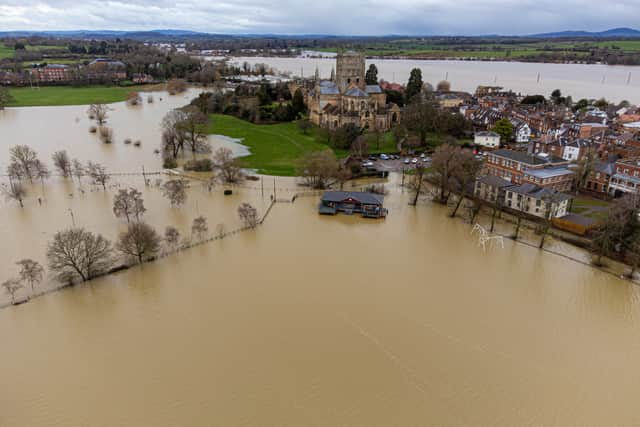Flood damage in UK could be cut by a fifth if climate targets are met, study suggests
and live on Freeview channel 276
Damage caused by floods in the UK can be reduced considerably if countries meet their internationally agreed climate targets, a study suggests.
If these targets are missed, and the average global temperature hits 3.3C above pre-industrial levels, the annual cost to properties and businesses could rise by more than a fifth, it warned.
Advertisement
Hide AdAdvertisement
Hide AdResearchers from the University of Bristol and flood modelling firm Fathom assessed the UK’s flood risk using the latest Met Office climate projections and found that damage levels can be reined in at just 5% above historical levels. But this can only happen if countries around the world honour the pledges they made at the UN climate conference Cop26 in Glasgow.


Countries which also made further net zero commitments, such as the UK, will have to meet those as well to prevent costs from flood damage rising to between 13% and 23%, the modelling showed.
Professor Paul Bates, lead author of the study and chairman of Fathom, said: “For the first time this flood model gives us a more accurate and detailed picture of the impact of climate change on the risk of flooding in the future across the UK.
“The results are a timely warning to the country’s political leaders and business sector that global commitments to significantly reduce carbon emissions must be taken very seriously, and ultimately take effect, in order to mitigate increased losses due to flooding.”
Advertisement
Hide AdAdvertisement
Hide AdResearchers said official maps, used to inform flood defence investment policy and long-term risk planning, lack transparency and are not peer-reviewed.
They described them as “insufficiently validated” and said the methods used to create them are “clouded in secrecy” and are unrepeatable, while calls for proper peer review of UK national flood risk assessments have gone ignored.
Which UK regions are most at risk of flood damage?
The data also showed regional differences in potential flood damage which hold true even if the average global temperature was limited to 1.8C above pre-industrial levels – slightly above the internationally agreed limit of 1.5C.
The areas at greatest risk of flood damage include:
- South-east England
- South Wales
- North-west England
- Central Scotland
The study found that densely populated cities such as London, Cardiff, Manchester, Glasgow and Edinburgh face possible damage increases of more than 25%. Elsewhere, North-east England, Central England and Northern Scotland would face around the same level of flood damage as they do today.
Advertisement
Hide AdAdvertisement
Hide AdProf Bates said: “Although the most optimistic climate scenarios see only modest increases in flood losses at a national level, these new data demonstrate how this conceals dramatic variations across the country, with some places seeing large changes and others very little. This is a result of changing patterns of future rainfall, river flow and sea level rise, and this leads to the regional differences we predict.
“We found that flooding increases most in places where risk is already high now, so the best thing we can do to prepare for the impact of climate change is to strengthen flood management in currently at-risk areas, and this will bring immediate economic and social benefits as well.”
The study has been published in the journal Natural Hazards and Earth System Sciences and was based on actual river flow, rainfall and tide-surge observations as well as climate model projections that matched with data on flood losses from the Association of British Insurers.
Co-author Dr Oliver Wing said: “This study, which harnesses new data and the very latest modelling techniques, validates Fathom’s UK Flood Map and has given a new level of insight into the impact of climate change on flooding in future. The modelling provides clear evidence that flood risk needs to be a bigger international priority and that current governance doesn’t go far enough.
Advertisement
Hide AdAdvertisement
Hide Ad“While the majority of the nation’s future flood risk already exists today, it is strongly in the UK’s interest to exercise leadership in global carbon emission reduction efforts, both by example and as part of global diplomatic initiatives.”
Comment Guidelines
National World encourages reader discussion on our stories. User feedback, insights and back-and-forth exchanges add a rich layer of context to reporting. Please review our Community Guidelines before commenting.
